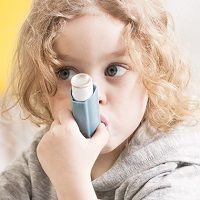Article
Study Finds Add-on Tiotropium Improved Lung Function in Adolescents with Moderate Asthma
Author(s):
Once-daily tiotropium added to inhaled corticosteroids was safe and well tolerated in a phase 3 trial in nearly 400 asthmatic adolescents.

Asthma is the most prevalent chronic disease in children and adolescents, and at least 40% experience symptoms and exacerbations despite maintenance treatment with an inhaled corticosteroid (ICS) with or without a long-acting beta-agonist (LABA). Because frequent exacerbations increase the risk that persistent asthma will develop in children, achieving asthma control and limiting exacerbations are the main goals in the treatment of young patients.
Current global guidelines recommend adding tiotropium (given via the Respimat device) to ICS plus LABA as an option in adults with a history of asthma exacerbations, and phase 2 trials in adolescents and children have shown that adding tiotropium to ICS provides lung function benefits similar to those seen in adults.
To determine the efficacy and safety of adding tiotropium delivered via the Respimat Soft Inhaler (Boehringer Ingelheim) to ICS therapy with or without leukotriene receptor antagonist therapy in adolescents with moderate symptomatic asthma, an international research team did a 48-week, double-blind, placebo-controlled parallel-group study. The study included 398 patients who were between 12 and 17 years old.
The team randomly assigned these adolescents to receive either 2.5 μg or 5 μg of tiotropium or placebo in a split dose of two puffs once daily in the evening. Patients were not permitted to use a LABA during the study.
By week 24, the team found statistically significant improvement in peak forced expiratory volume in 1 second (FEV1) within 3 hours after dosing with either dose of tiotropium compared with placebo. Peak FEV1 improved by 134 mL (95% confidence interval [CI], 34—234 mL) with the 2.5-μg dose and by 174 mL (CI, 76–272 mL) with the 5-μg dose.
Although the study met this primary endpoint for both doses, a secondary endpoint, significant improvement in trough FEV1 at week 24, was only met with the 5-μg dose.
In addition, the team observed a trend toward improvement in asthma control and health-related quality of life throughout the 48-week treatment period.
The team reported that the incidence of adverse events was comparable across treatment groups. The incidence of drug-related adverse events was low, and most were mild or moderate in intensity.
Adverse events reported in more than 5% of study patients included asthma (including worsening or exacerbation), nasopharyngitis, viral respiratory tract infection, decreased peak expiratory flow rate, headache, and viral infection.
Serious adverse events were reported in seven patients, but none was considered drug-related. No deaths occurred during the study.
On the basis of these results, the team concluded that once-daily tiotropium improved lung function and was safe and well tolerated when added to ICS maintenance therapy in adolescents with moderate symptomatic asthma. However, they noted that the 5-μg dose resulted in larger responses than the 2.5-μg dose.
Related Coverage:
- Once-Daily Tiotropium Found to be Safe and Tolerable in Combination with Inhaled Corticosteroids
- Weight Gain Worsens Asthma Control, According to Study
- Imaging Study Finds Systolic Dysfunction, but no Diastolic Dysfunction, in Children with Asthma




